The Shrimad Bhagwat Geeta – Bhagavad Gita is the sacred scripture of Hinduism. It is an independent, standalone philosophical treatise in itself but is an integral part of another great Indian epic, the Mahabharata. The Bhagavad Gita goes beyond religion and is an entire philosophy of life which deciphers the purpose and meaning of life. The great scripture Bhagavad Gita is the cornerstone of Hindu religious philosophy and spirituality, it is a synthesis of various aspects of Hindu thought and socio-religious dogmas.
Table of Contents
Shrimad Bhagwat Geeta | Bhagavad Gita – An Introduction
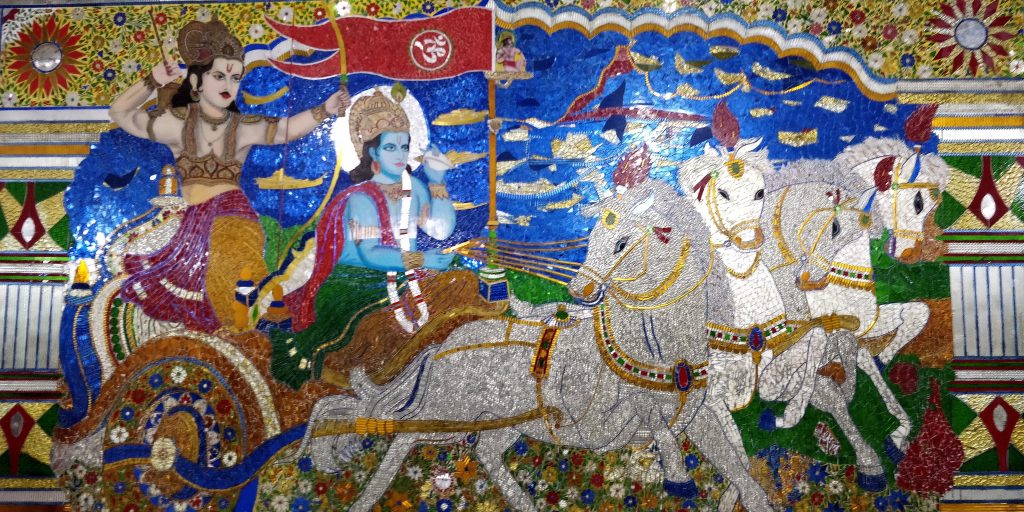
The Bhagavad Gita – Shrimad Bhagwat Geeta is the font of the philosophy based on Karma and its precepts can be incorporated in day to day life and work and have even found their way into Management principles. So what is the Bhagavad Gita? How old is the Gita? How is the Bhagavad Gita structured? These are some questions that we examine in the following paragraphs.
Shrimad Bhagwat Geeta | Bhagavad Gita Structure And Essence
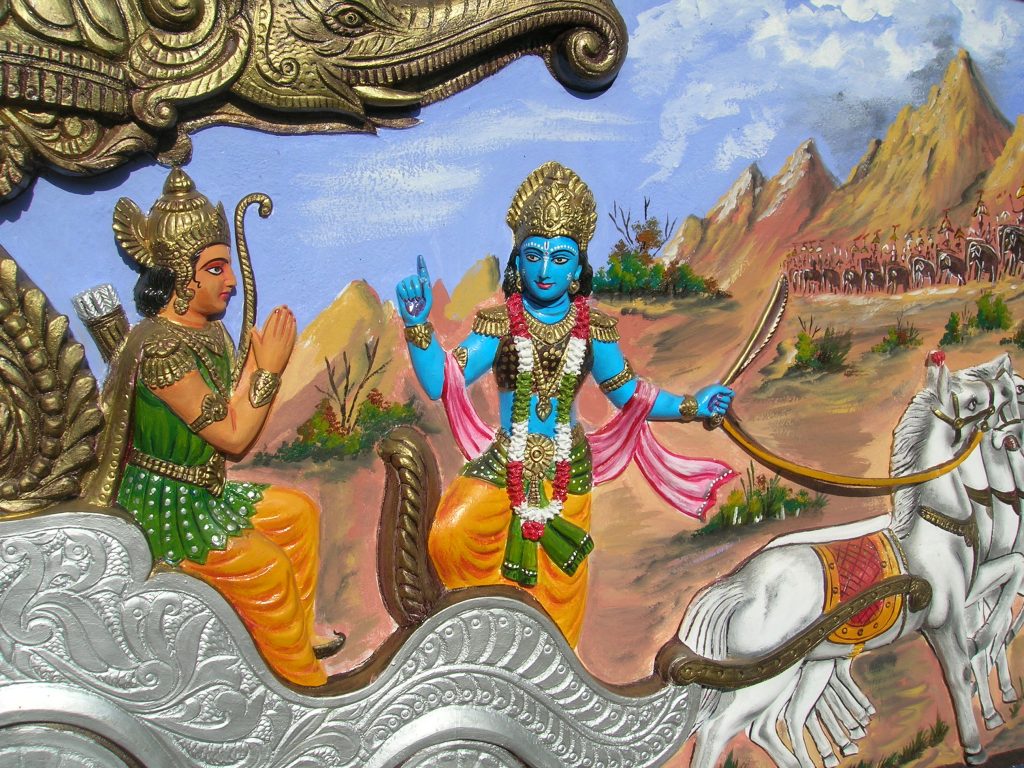
The Shrimad Bhagwat Geeta has attracted the attention of philosophers, thinkers, and spiritual leaders from time immemorial. Commentaries and interpretations of the philosophy of the Gita have been written from luminaires including the likes of Adi Shankaracharya and Swami Vivekananda.
Traditionally and historically Hindu thought has evolved and blossomed through a question and answer method. The student fueled by curiosity questions his teacher or Guru, who enlightens him with his answers. We follow a similar pattern as we introduce the basics of the Bhagavad Gita through a series of questions and answers here.
What is the Shrimad Bhagwat Geeta | Bhagavad Gita?
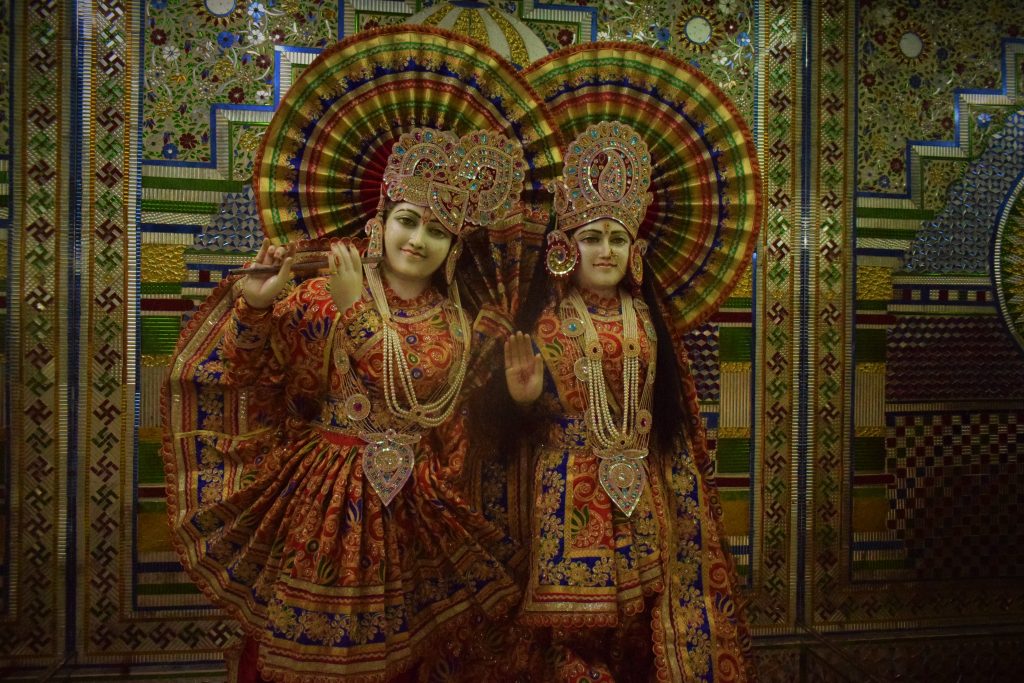
The Shrimad Bhagwat Geeta – Bhagavad Gita which literally means, “The Song of God,” in Sanskrit is an ancient Hindu scripture which is part of the Mahabharata. 700 verses make up the Bhagavad Gita which is actually in the form of a series of dialogues between Krishna, the 8th avatar of Lord Vishnu, and Arjun.
In the Mahabharata, a series of events conspire and lead to the battlefield. The Pandava brothers and their allies including Krishna are on one side while the 100 Kaurava brothers and their allies or on the other. At stake is the kingdom of Hastinapur. Both the armies face each other on the battlefield known as Kurukshetra.
The war is about to begin when Arjun who has Krishna as his charioteer is benumbed with doubts and filled with trepidation at the thought of waging war and killing his own kinsmen. The dilemma of Arjuna erupts in questions directed at Krishna and the answers of Krishna bring solace to Arjun who is torn by conflicting thoughts. This dialogue between Krishna and Arjun is the Bhagavad Gita.
What Is The Structure of Shrimad Bhagwat Geeta | The Bhagavad Gita
The Gita is made up of 18 chapters which together contain 700 verses or shlokas. Each of the verses is made up of a couplet, which means that the entire Bhagavad Gita is made up of 1400 lines.
How Old Is The Shrimad Bhagwat Geeta | Gita
The Gita is over 5,000 years old and is believed to have originated in the Dwapara Yuga during the Kurukshetra war between the Pandavas and the Kauravas.
In Which Language Is Shrimad Bhagwat Geeta | The Bhagavad Gita
The original scripture is in Sanskrit, while it has been translated in multiple Indian and foreign languages including English.
Who Wrote Shrimad Bhagwat Geeta | The Bhagavad Gita
The credit for writing the Bhagavad Gita goes to the sage Veda Vyasa who wrote the epic Mahabharata, which includes the Bhagavad Gita.
What Is The Message of Shrimad Bhagwat Geeta | The Gita
The Shrimad Bhagwat Geeta – Bhagavad Gita addresses various issues that range from the simple issues of life to philosophy and spirituality. The Gita stresses the perishability and impermanence of life and the immortality of the soul. It also underlines the importance of doing your duty, karma, without dwelling on the results.
The Shrimad Bhagwat Geeta – Gita also stresses that the soul transmigrates from one physical entity to another based on its merits or demerits. The Gita is probably the only scripture that presents a logical explanation to the inequalities that we see everywhere.
Shrimad Bhagwat Geeta | Bhagavad Gita Chapters At A Glance
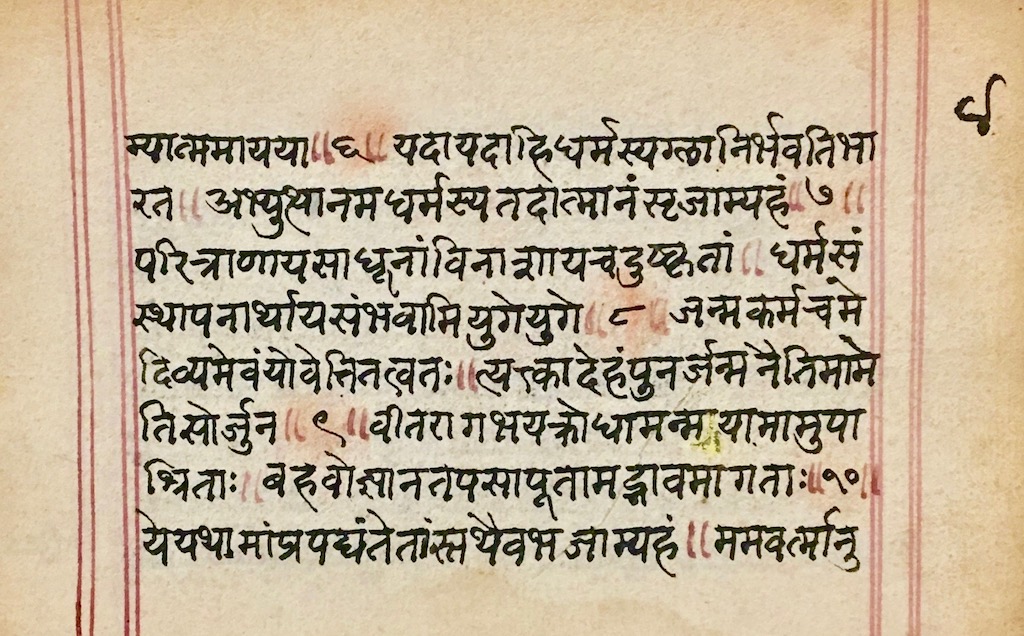
The main characters of the Gita are of course Krishna and Arjuna. However, the dialogues between the two are presented as a commentary narrated by Sanjaya to the blind king Dhritarashtra, as indeed the entire Mahabharata is. Here we take a look at what each chapter of the Gita contains.
Bhagavad Gita Chapter 1
Arjun Vishada Yoga – Lamenting The Consequences of War
The first chapter is an introduction of sorts. It introduces the characters, the settings, and talks about the despair and dilemma that Arjun experiences seeing his kinsmen lined up for war.
Bhagavad Gita Chapter 2
Sankhya Yoga – Immortality of The Soul
The second chapter of the Gita is considered by many to contain the essence of the message of the Bhagavad Gita. The chapter dwells on various subjects that include Karma Yoga, Jnana Yoga, Sankhya Yoga, etc., the soul and its immortal nature is explained by Krishna to Arjuna.
Bhagavad Gita Chapter 3
Karma Yoga – Focus on Karma or Actions
Chapter 3 of the Gita focuses on the importance of Karma, discharging your duties as per the rules of society at every stage in your life. It also explains how one can attain salvation by the dispassionate discharge of one’s duties, through the path of Karma Yoga.
Bhagavad Gita Chapter 4
Jnana Yoga- The Path of Knowledge
This chapter throws light on why Krishna has appeared in the material world, the path of knowledge that leads to the realization of the ultimate truth. The two paths of Karma and Jnana are explained as also how both paths converge on to the realization of the supreme truth.
Bhagavad Gita Chapter 5
Karma Vairagya Yoga – The Path of Renunciation
This chapter reveals the relation between action and renunciation. How to do your Karma while at the same time renuciating yourself from the fruits of the action or Karma. How the paths of action and renunciation lead to the same goal, salvation.
Bhagavad Gita Chapter 6
Dhyana Yoga – Realizing The Self
The essence of this chapter is the mind and how to harness the energies of the mind to know one’s true self and attain knowledge of the self. This is achieved through the practice of Yoga.
Bhagavad Gita Chapter 7
Jnana Vijnana Yoga – The Ultimate Truth
In this chapter, Krishna unveils the absolute reality, the ultimate truth and how it is submerged under layer upon layer of illusion or Maya.
Bhagavad Gita Chapter 8
Akshara Parabrahma Yoga – Towards Salvation
Krishna leads Arjuna towards the knowledge of discrimination between the spiritual and material worlds in this chapter. He also explains the two paths that lead out of the material world, one the path of darkness and the other of light.
Bhagavad Gita Chapter 9
Raja Vidya Yoga – The Most Confidential Knowledge
Krishna imparts the most secret and confidential knowledge of the universe to Arjun. He explains how everything in the universe is created and then destroyed, how all being immersed with his being
Bhagavad Gita Chapter 10
Vibhuti Yoga – The Magnificence Of The Ultimate Truth
This chapter dwells on the divine attributes of the supreme God. The origin and source of which is unknown even to the sages and Gods themselves.
Bhagavad Gita Chapter 11
Visarupa Darshan Yog – The Universal Form Revealed
This chapter is famous for the revelation of his universal form by Krishna to Arjun.
Bhagavad Gita Chapter 12
Bhakti Yoga – The Path of Devotion
This chapter dwells on the path of devotion to attain salvation. Krishna explains to Arjun how a person can become close to him by single-minded devotion to him, irrespective of his knowledge.
Bhagavad Gita Chapter 13
Kshetra Kshetrajna Vibhag Yog – The Body, The Mind, And The Soul
In this chapter, Krishna explains to Arjuna the difference between the physical body and the spiritual body or the soul. He explains the concepts of Aatma and Paramatma.
Bhagavad Gita Chapter 14
Gunatraya Vibhaga Yoga – The Triple Attributes of Materialism
The three Gunas or attributes associated with the material world are termed as Sattva, Rajas, and Tamas. The distinction between these attributes and their dynamics is explained by Krishna in Chapter 14 of the Bhagavad Gita.
Bhagavad Gita Chapter 15
Purushottama Yoga – The Ultimate Truth
The divine qualities of the Purushottam or absolute God is described in this chapter. The omnipresence, omnipotent, and eternal presence of the divine entity Purushottam or Supreme God are also underlined.
Bhagavad Gita Chapter 16
Daivasura Sampad Vibhaga Yoga – Differences Between Demonic And Divine Nature
This chapter clearly defines the attributes possessed by those who have a pure and divine nature as opposed to those who have a demoniac nature.
Bhagavad Gita Chapter 17
Shraddhatraya Vibhaga Yoga – Three Types of Faith
This chapter has Krishna explaining three types of faith that people may exhibit based on their previous Karmas and circumstances. He explains the attributes as well as the consequences of each of these.
Bhagavad Gita Chapter 18
Moksha Upadesha Yoga-True Renunciation
In this chapter of the Bhagavad Gita, Krishna clears Arjun’s doubts about renunciation. He explains true renunciation lies in the renunciation of the fruits of action rather than the renunciation of the action itself.
Some Famous Bhagavad Gita Shlokas |Popular Gita Quotes
Bhagavad Gita Chapter 4, Verse 7 & 8
यदा यदा ही धर्मस्य ग्लानिर्भवति भारत I
अभ्युत्थानमधर्मस्य तदात्मानम सृज्याहम II
परित्राणाय साधूनां विनाशाय च दुष्कृताम I
धर्म संस्थापनार्थाय संभवामि युगे युगे II
Whenever there is a decline in truth and righteousness and there is an increase in all that is false and unrighteous, I myself descend into the material world to re-establish Dharma.
Bhagavad Gita Chapter 2, Verse 23
नैनं छिन्दन्ति शस्त्राणि नैनं दहति पावकः।
न चैनं क्लेदयन्त्यापो न शोषयति मारुतः॥
Weapons cannot shred the soul, nor can fire burn it. Water cannot wet it, nor can the wind dry it.
Bhagavad Gita Chapter 9, Verse 26
पत्रं पुष्पं फलं तोयं यो मे भक्त्या प्रयच्छति |
तदहं भक्त्युपहृतमश्नामि प्रयतात्मन: ||
If one offers to Me with devotion a leaf, a flower, a fruit, or even water, I delightfully partake of that article offered with love by My devotee in pure consciousness.
We hope you liked our introduction of the Bhagavad Gita – Shrimad Bhagwat Geeta as well as these famous Gita quotes. We shall be back soon with details of Bhagavad Gita Chapter 1. For more interesting articles subscribe to our blog and follow us on our social media channels.

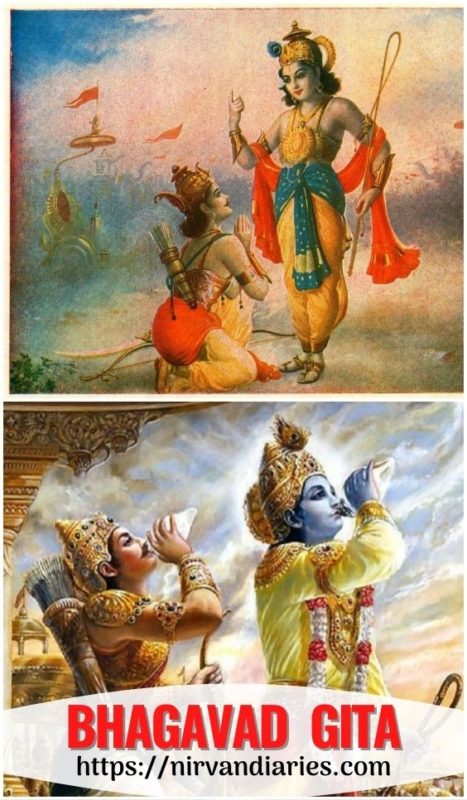
Thanks for visiting our site nirvandiaries.com and taking the time to read this post.
If you wish to collaborate or work with us then reach us at [email protected]
We’d love if you’d comment by sharing your thoughts on this post and share this post on social media and with your friends.
Follow our journey on our social media channels:
Facebook Twitter Instagram Pinterest
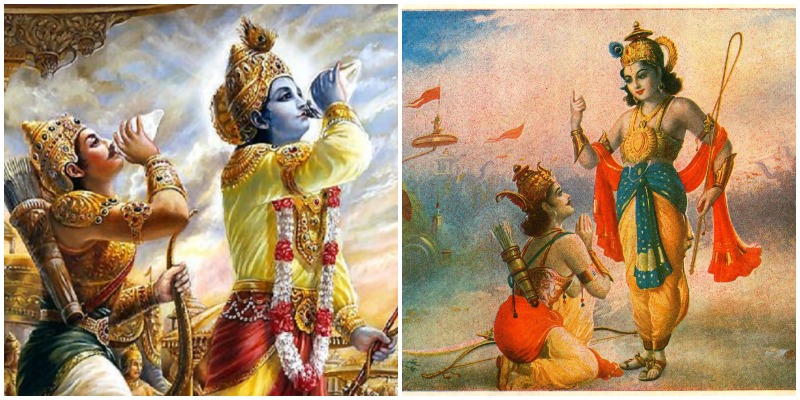

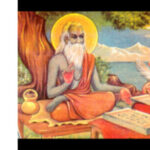
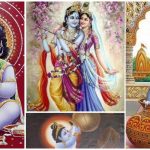


I knew so less about this Holy Book. Really appreciate your hard work. I must read now.
I knew so less about this Holy Book. Really appreciate your hard work. I must read now.
You have explained this holy scripture in great detail. It was easy to understand and the information shared was bite sized. This made itt even more appealing
Bhagwat Geeta is a divine communion of truth-realization between man and his Creator. Through this post, you allowed your reader to quick go through about Bhagwat Geeta and its lessons.
It is one of the best scriptures in the world and so fascinating. I have read it.
It is one of the best scriptures in the world and so fascinating. I have read it and was pleasantly pleased.